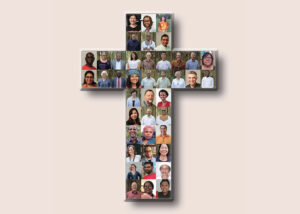In early 2000, when I first stepped into the sanctuary of Willingdon Church in Burnaby, B.C., I was astounded to see the music team’s diversity. A variety of races and ethnicities was represented, singing a chorus praising God.
This Mennonite Brethren church would become one of the biggest megachurches in the Greater Vancouver area, known for welcoming people from all walks of life, in contrast to a leadership team made up entirely of white people (though that has since changed).
According to Chanequa Walker Barnes, a scholar, theologian and clinical psychologist whose work focuses on healing the legacies of racial and gender oppression, “A congregation does not become multicultural through a recipe that says, ‘add diversity and stir.’”
In an article for the Collegeville Institute, titled “How multicultural churches can succeed,” she prioritizes the transformation of leadership as a precursor for the success of multicultural churches beyond the level of cosmetic diversity. The true intercultural church pursues a balanced representation both in the pew and in positions of power.
The intercultural church begins with an unswerving initiative to form an interracial leadership team, deconstructing and dismantling power and privilege imbalances in the group. There is no way to build an intercultural church but on the rock of diversity behind the pulpit, rather than on the sands of homogenous leadership (which can lead to the false assumption that “the best person always looks like us”). This means that an intercultural church does not happen out of random prayer and wishful thinking.
I, a first-generation Korean immigrant man, co-pastor Holyrood Mennonite Church in Edmonton with Suzanne Gross, a white, Swiss Mennonite woman born in the United States. Our congregation has 40 or so active members (plus many kids) representing nine distinct ethnicities: Swiss, German, Polish, Hungarian, Liberian, Ghanaian, Sierra Leonean, Congolese, and Korean.
Yes, having an interracial pastoral leadership team sometimes leads to complexities and challenges in helping the diverse and flexible congregation stabilize. But it also grants us perfect soil to pursue an intercultural church because no one sticks to their comfort zone (we are receptive to new ideas), no one monopolizes power (we practice humility), and no one resists a venturesome spirit (we cultivate curiosity).
Interracial pastoral leadership teams are not new to the North American Mennonite church. It humbles me to know that the first interracial pastoral leadership team was in ministry at Woodlawn Mennonite Church in Chicago in the late 1950s. The co-pastors were Vincent Harding, a Black man, and Delton Franz, a white man.
Unfortunately, this wonderfully interracialized leadership did not last. Feeling at times like he was an “exhibit” on display in the Mennonite church—“our Negro Mennonite pastor”—Harding left this community in 1961. To a few Mennonite leaders, Harding was regarded as a modern prophet sent to awaken the “quiet” Mennonite church in dealing with societal racism. Joanna Lawrence Shenk, a Mennonite pastor in San Francisco, interviewed Harding and noted in an Anabaptist World article that he “was allowed to be present but not allowed to set the agenda, since his perspective was ‘too radical.’ ”
More than 65 years have passed since Harding was installed at Woodlawn. The Mennonite churches in both Canada and the United States, dominated by white people, still struggle with the need to form true interracial leadership while wishfully dreaming of diversity.
Chanequa Walker Barnes’ fivefold advice for the success of interracial leadership is pertinent here:
- Every member of the core leadership team must believe that diversity is God’s desire for the Church universal, and the guiding principle for the local congregation.
- Members of the core leadership team must continuously learn from people of colour and other marginalized cultural groups, both within and outside the congregation.
- Concepts connected to race, culture, privilege and oppression must be part of the core leadership team’s everyday vocabulary. They should be always asking the question, “How does culture play into this?”
- The leadership team must attend to its unity and health on a regular basis. This includes developing healthy attitudes and coping mechanisms for addressing conflict.
- Do not be afraid of failure. Embrace conflicts as learning opportunities.
Our job is to plant the seed of intercultural ministry humbly, transparently, and ceaselessly. The rest is God’s business.
Joon Park serves as intentional interim co-pastor at Holyrood Mennonite Church in Edmonton. He can be reached at cwcfounder@gmail.com.
Read more Riding the Waves of Intercultural Church columns:
The hopeful demise of ethnocentrism
Four models of multiracial church
The witness of heterogeneity
Revisiting intentionality
Three kinds of grace in the formation of intercultural church








Leave a Reply
You must be logged in to post a comment.